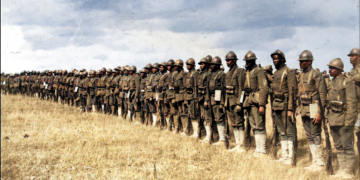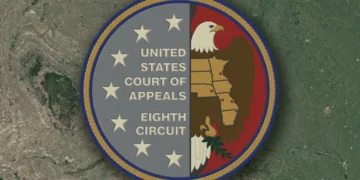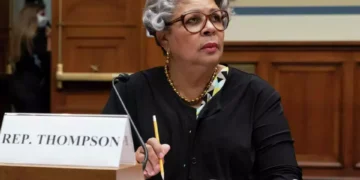March 9, 2025 Story by: Publisher
In 1965, at the height of the modern civil rights movement, activists organized a march for voting rights, from Selma, Alabama, to Montgomery, the state capital. On March 7, some 600 people assembled at a downtown church, knelt briefly in prayer and began walking silently, two-by-two through the city streets.
With Hosea Williams of the Southern Christian Leadership Conference (SCLC) leading the demonstration, and John Lewis, Chairman of the Student Nonviolent Coordinating Committee (SNCC), at his side, the marchers were stopped as they were leaving Selma, at the end of the Edmund Pettus Bridge, by some 150 Alabama State Troopers, Sheriff’s deputies, and possemen, who ordered the demonstrators to disperse.
One minute and five seconds after a two-minute warning was announced, the troops advanced, wielding clubs, bullwhips, and tear gas. John Lewis, who suffered a skull fracture, was one of fifty-eight people treated for injuries at the local hospital. The day is remembered in history as “Bloody Sunday.” Less than one week later, Lewis recounted the attack on the marchers during a Federal hearing at which the demonstrators sought protection for a full-scale march to Montgomery.
Background
The early spring of 1965 became the turning point in the tensely-waged struggle for voting rights throughout Alabama and the “Deep South.” For many months, organizers of the Southern Christian Leadership Conference (SCLC) and the Student Non-Violent Coordinating Committee had conducted a series of non-violent marches and mass meetings in preparation for major activities in the key central Alabama counties of Green, Hale, Wilcox, Perry, Dallas, Lowndes and Montgomery.
A court injunction intended to curtail their marching in Selma failed in January and the increased involvement of a broader spectrum of participants now enlarged the scope of civil rights activities.
On February 18, 1965, a groundbreaking night march in Marion in Perry County conducted by SNCC was met with elevated brutality from state troopers and Marion police. In the terse melee that followed, youth leader Jimmie Lee Jackson was killed as he sought to protect his mother and grandfather from attack. After being refused medical attention in Marion, Jackson was transported twenty miles to the Good Samaritan Hospital in Selma, where he died seven days later.
In the days that followed, a variety of responses to Jackson’s murder was considered by the SCLC and SNCC leadership. The most provocative was to march to Montgomery and place the martyr’s body on the steps of the state capitol building. While this idea in part was rejected, the concept of the march to the state capitol was inspirational.
A concerted plan was developed by the key organizations involved to conduct a profoundly overt act that would decisively weigh the scales in favor of voting rights. The plan was to march the 54 miles from Selma to Montgomery where a rally would be held on the steps of the state capitol and where movement leaders intended to meet with Gov. George Wallace.
Approximately at 3 p.m. on Sunday, March 7, 1965, 300 protestors, led by Hosea Williams, John Lewis, Albert Turner, and Bob Mants, gathered at Brown Chapel A.M.E. Church in Selma and proceeded through town to the Edmund Pettus Bridge. At that point, the number of the marchers had swelled to 600 as they crossed the span from Selma toward their date with destiny. At the end of the bridge stood Alabama State Troopers and a hastily organized vigilante band mounted on horses under the direction of Maj. John Cloud. Refusing to speak to Williams, Cloud ordered the marchers to disperse, after which gas canisters were thrown into the crowd. Troopers and horsemen armed with clubs assaulted the protestors who then fled back to Selma.
During the pandemonium that reigned throughout the afternoon, hundreds of non-violent protestors were injured. They were treated at Good Samaritan Hospital and a local clinic. The remaining protestors gathered for a rally at Brown Chapel.
Captured on film and broadcast across the nation, this event galvanized the forces for voting rights and increased their support. “Bloody Sunday” became a landmark in American history and the foundation for a successful campaign culminating with the passage of the Voting Rights Act of 1965.
Source: National Park Service

















